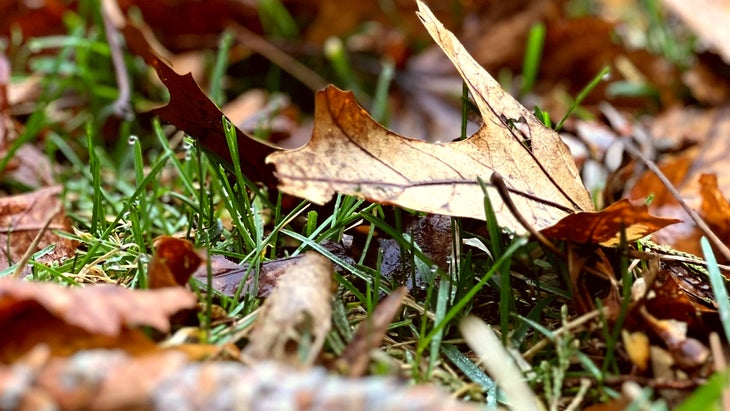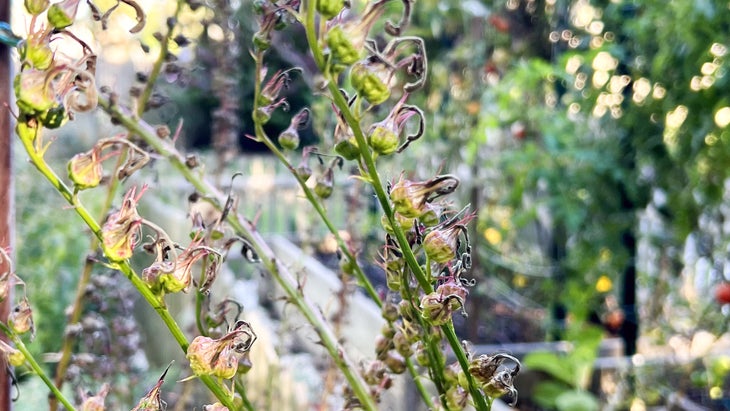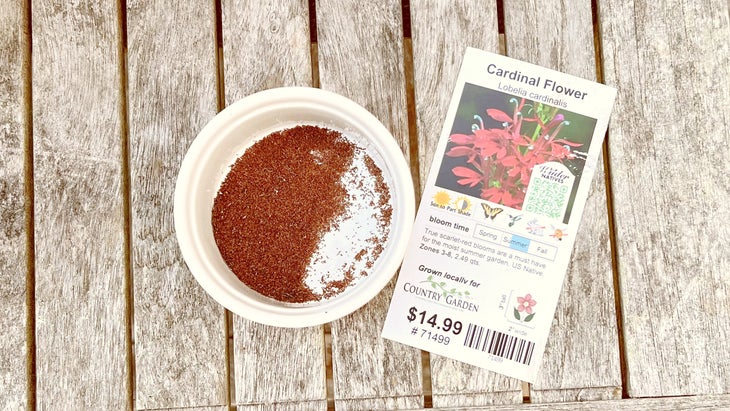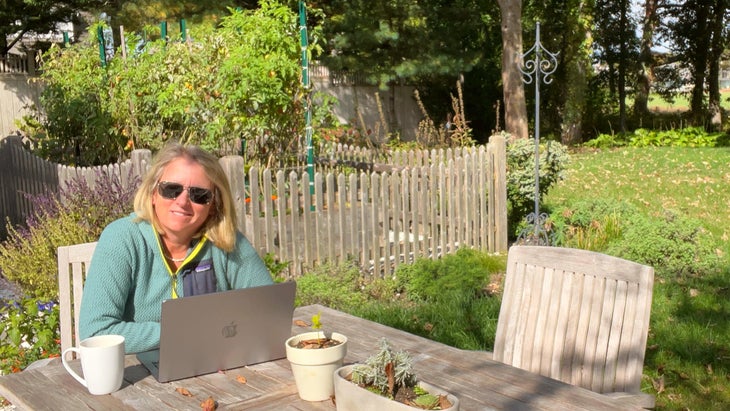The leaves are starting to fall here in New England and that perennial urge to bust out the rake and leaf blower is nagging at me. But for the first time in, well, forever, I will resist that urge. Because it turns out, raking up and bagging or burning those leaves is not only bad for soil health. It also takes away habitat for important wildlife like bugs and birds, who are critical pollinators.
I know what you’re thinking. What will my neighbors think if I ignore my yard work? We’ve been taught—by society, by our homeowner’s associations, by our parents, and by our landscapers—to keep our yards clean and tidy. To remove leaves and branches as they fall. To whack back our shrubs and perennials after they bloom. And to invest in big fall and spring clean-ups that scour our flower beds free of debris. Your neighbors might think the alternative—a yard with fallen leaves, long grass, and flowers gone to seed—is untidy, or even a threat to property values and health (by attracting bugs and animals).
Climate Action Tips
Get more climate action tips in our Climate Neutral-ish newsletter.But ecologists say we need to rethink our preconceived notions of beautiful, well-maintained yards. Lawns comprise 44 million acres in the U.S. alone, more than double the acreage of all our national parks combined. And as satisfying as a perfect green lawn may be, it’s an ecological dead zone that doesn’t support any of the essential functions—like pollination, carbon sequestration, and nutrient recycling—that sustain our ability to live on this planet.
According to a by NatureServe, a nonprofit specializing in biodiversity data, more than one third of species and ecosystems in the U.S. are at risk of disappearing. This kind of biodiversity loss would be catastrophic for humans, ecologist and entomologist Doug Tallamy told me in an interview for a story I wrote about rewilding.
Thankfully, natural landscaping is trending. According to House Beautiful, the practice—which includes native perennials, wildflower and pollinator gardens, xeriscaping, and lawn reduction—is one of . That’s good news for folks on a budget (and those who want to reclaim their fall weekends) because natural landscapes are way less cost- and time-intensive to maintain. It’s also good news for all the bugs, birds, and bees, which are so critical for biodiversity.
But back to raking. As I write these words, I can hear the buzz of leaf blowers in my neighborhood. I can see a big truck piled high with collected leaves, about to be carted off to who knows where. Meanwhile, in my yard, I’m watching them fall and wondering how to harness their glory.
Why Experts Say Don’t Rake
“Leaves are not litter,” says Matthew Shepherd, the director of outreach and education at Xerces is a nonprofit focused on protecting and conserving insects and other invertebrates. “They provide critical food and shelter for butterflies, beetles, bees, moths, and other invertebrates. And we need to stop thinking of these tiny creatures as pests, but rather as heroes. Instead of banishing them from our spaces, we need to roll out the welcome mat.”

Insects are critical to humans because they transfer pollen from plant to plant, which helps plants and crops reproduce. “Without these pollinators, and ample habitat for them, our global food supply would be drastically diminished,” says Shepherd. Insects are also a valuable food source for birds, reptiles, and other insects, and they help aerate soil and decompose organic matter.
Additionally, leaf debris helps build healthy soil that holds moisture. Leaves are nature’s fertilizer: free, nutrient-dense organic matter that breaks down and feeds the soil. It’s pretty ironic that we sweep our yards clear of them and then run to the garden center to buy chemical fertilizers (which, according to The Freedonia Group, a market research firm, is a $4 billion market).
Here’s How to Get the Most Out of Your Leaves
As I watched the leaves pile up on my lawn, I started to wonder whether there were any downsides to letting them be. Is there such a thing as too much leaf litter? What if they dried out—could they be a fire hazard? I reached out to Jamie “Dekes” Dedekian, an organic lawn expert I’ve come to trust at my local garden center, Country Garden, in Hyannis, Massachusetts, to get some basic best practices.
“If you let leaves build up on your lawn over time, and just let them sit, the answer is yes, they will smother and could kill it,” Dedekian told me. But the answer is not to do a big fall clean up. Instead, he recommended a few easy “clean-in” techniques that will harness all the goodness in those leaves and distribute them in a beneficial way across your yard.
As they start to fall, blow whole leaves into your flower beds, where they’ll create wildlife habitat and eventually decompose and feed the soil and plants. Once you’ve created a blanket in the beds that’s a few inches thick, then it’s time to feed the lawn some leaves. “Remove the bag on your mower and mulch them up into small pieces,” he says. “It’s essentially a free compost application. As those small bits of leaves decompose they will actually help your lawn, not hurt it.”
If you live in a wildfire-prone area, you will also benefit from some leaf redistribution, because dry leaf litter can pose a fire hazard in hot, dry, windy conditions. Shepherd suggests raking them into a pile a safe distance away from structures—the U.S. Department of Agriculture at least 30 feet from the home—and letting them decompose naturally there.
“Even a small pile of leaves can make a positive impact,” Shepherd says. “Just find a corner of your yard, make a pile, and let it be. The animals will find it, and they’ll appreciate it.”

5 Pro Fall Tips for the Eco-Conscious Gardener
As I wrapped up my conversation with Shepherd, I asked him what yard tasks I can be doing to improve the health and beauty of my space this fall. After all, I love gardening and yard work, and with less raking to do, I’d have lots of time on my hands. Here are his ideas.
1. Relax and watch. “Just sit and enjoy your morning coffee while watching the finches feed on your seed heads and the bees buzz around the last of your lavender,” says Shepherd. “Sometimes protecting and promoting habitat means doing less. Part of gardening should be just sitting back and enjoying it. Actually taking time to notice and watch and appreciate the wildlife that you’re bringing in.” It’s also a good time to make notes about plants that thrived and those that didn’t, and make a list of new plants you want to try next year. Think about your bloom period through the year. “Did you have periods when you didn’t have a lot of bloom? Are there native plants you could introduce to fill those gaps?” he says.
2. Collect seeds. Are there plants you love and want more of? For me this year it was cardinal flowers, which drew hummingbirds into my yard every day. I’m leaving many of the seed heads intact for the birds to feed on, but I’m collecting some to plant.

3. Make a brush pile, also known as habitat pile. Find a lonely corner of your yard and start building a pile of sticks and branches for animals to. Start with the largest logs and branches on the bottom, and keep adding as time goes on. Be sure to leave gaps for airflow and wildlife access.
4. Save the stems. Some bees nest in the stems of shrubs and perennials, so resist the urge to chop them down to nubs.
5. Split native perennials. Fall is a great time to divide many plants. Dividing entails digging plants up and splitting the root ball into smaller sections to replant in different spaces. This practice promotes growth and is a great way to fill in gaps in your garden. I’ve got tons of splitting to do this fall: black-eyed Susans, daisies, catmint, sedum, and lavender to name a few.

Kristin Hostetter is �����ԹϺ���’s sustainability columnist. On most weekends when she’s not out hiking, you can find her puttering in her garden or in the kitchen cooking up the fruits of her labor. Follow her journey to live more sustainably by for her twice-monthly newsletter.
